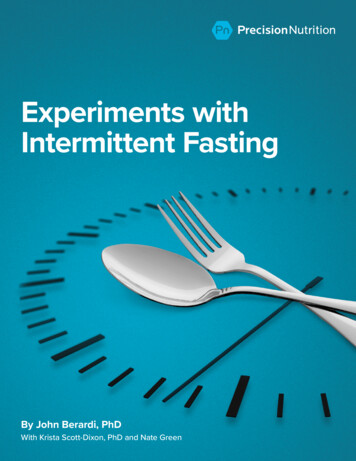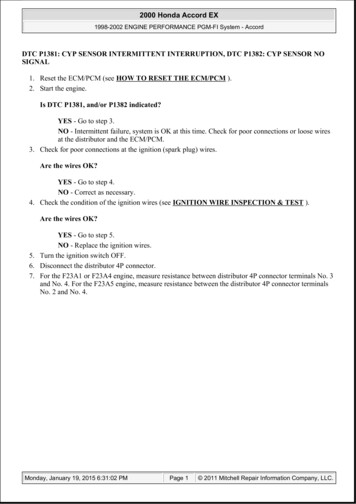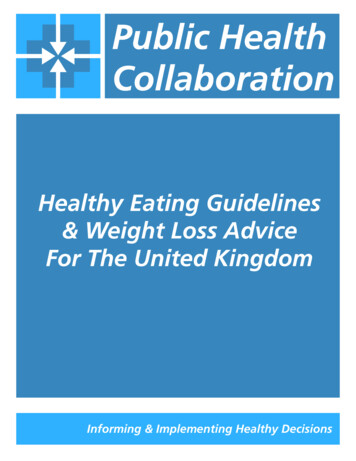
Transcription
Intermittent Fasting (Time-Restricted Eating)Fed vs. FastedYour body is designed to smoothly transition betweentwo different and opposing states: ‘Fed’, and ‘Fasted’.In the fed state, insulin is elevated, and this signals yourbody to store excess calories in your fat cells. In thepresence of insulin, the burning of fat is halted, whilethe body burns glucose (from your last meal) instead.In the fasted state, insulin is low (while glucagon andgrowth hormone, opposing hormones to insulin, areelevated). The body starts mobilizing stored body fatfrom your fat cells and burning this fat for energy(instead of glucose).The practical importance of all this? You can only burnstored body fat while in the fasted state, and you canonly store more body fat while in the fed state.Insulin ResistanceUnfortunately, over time we seem to be spending less and less of our time in the fasted state and more andmore time in the fed state. As a result, our bodies and our cells spend less and less time mobilizing andburning stored body fat for energy, and the glucose-burning pathways are overused.Eventually, insulin is high all the time and the body avoids burning stored body fat, relying mostly on glucose.Over time, this chronic exposure to so much insulin also leads to ‘insulin resistance’ where the body secreteseven more insulin in response to the fed state. Chronic insulin resistance is the cause of ‘MetabolicSyndrome’: obesity, abdominal fat storage, high triglycerides, low HDL or “good” cholesterol, and elevatedglucose with eventual type 2 diabetes (1 in 12 humans on earth currently have full blown type 2 diabetes,while 35% of adults and 50% of older adults have Metabolic Syndrome, or pre-diabetes).Someone with insulin resistance is burning predominately glucose on the cellular level, and they rarely everget the opportunity to burn any body fat. When these people run out of glucose from their last meal, insteadof easily transitioning over to the fasted state to burn fat, they become hungry for more glucose (fromcarbohydrates) as their bodies and cells have decreased capacity for mobilizing and burning fat for energy.Let’s put it this way. Why would a highly obese person EVER be hungry? They have enough fat stores to lasta very long time. The world record for fasting went to a 456 pound man who fasted for 382 days, consumingonly water and vitamins and losing 276 pounds with no ill effects. But the average overweight person is usedto being in the fed state, has very little practice in the fasted state, and is continually burning glucose ratherthan fat at the cellular level. They have insulin resistance, which is both caused by and also leads tochronically high insulin levels, which promotes fat storage and suppresses fat mobilization from theadipocytes (fat cells). They even have changes in the mitochondria, or tiny energy factories inside the cells.The mitochondria can burn either glucose (sugar) or fat for fuel, and over time they will have a preference forone over the other; “sugar burners” have increased the pathways in the mitochondria that burn glucose anddecreased, or down-regulated, the underused pathway for burning fat. So what happens to the overweight“sugar burner” who stops eating for a few hours? As they run out of glucose from their last meal, instead ofseamlessly transitioning to the fasted state and mobilizing and burning stored body fat, they become
HUNGRY for MORE GLUCOSE, from carbohydrates! They will spend most of the day trapped in a cycle ofeating every few hours, spiking glucose, and then becoming hungry when blood sugar drops.A good analogy is that of a tanker truck on the freeway filled with oil. If the tanker truck runs out of gas itstops moving, despite the fact that it has 10,000 gallons of potential fuel on board. Why? Because it prefersto run on refined gas and is incapable of burning oil for fuel.Fat AdaptationHumans have the ability to become ‘fatadapted’ and improve their ability to fuelthemselves with stored body fat insteadof glucose. However, this takes timeand practice, and your body has to do anumber of things to slowly up-regulate(or increase) your fat-burning pathways.This includes improving insulin sensitivityto lower insulin and promote fatmobilization into free fatty acids from theadipocytes (fat cells) as well as upregulating the fat-burning pathways atthe cellular level (in the mitochondria).There are several ways to improve ‘fatadaptation’ or the ability to successfullyburn stored body fat for energy, andthese include the following: Low carbohydrate diets. Eating a LCHF (Low Carb High Fat) diet improves the body’s ability to utilize fat for energy rather than glucose, as there is more fat and less glucose available at all times, even in thefed state.Exercise. High-intensity exercise depletes glucose and glycogen rapidly, forcing the body to switch overand utilize more fat for fuel. Exercise also improves insulin sensitivity.Caloric restriction. Eating fewer calories also equals less glucose available for fuel, so the body is morefrequently forced to rely on stored body fat for fuel. You will always naturally eat the lowest calorieswhen you are maximizing nutrient density by eating whole, natural, unprocessed, real foods found innature (avoid processed foods completely).Intermittent fasting, and spending more time in the fasted state, which gives the body more ‘practice’ atburning fat.Metabolic ExerciseThe purpose of this is to highlight INTERMITTENT FASTING as a strategy for exercising and strengtheningthe body’s ability to exist in the fasted state, burning fat instead of continually burning sugar (glucose) fromthe fed state.Just like anything else, this ability can be strengthened over time with practice. But this ability also atrophiesor shrinks over time with lack of use, just like your muscles atrophy when you break your arm and have towear a cast for weeks.Spending time in the fasted state is actually a form of exercise—a METABOLIC WORKOUT.
In fact, there are a lot of parallels between exercise and fasting.Exercise does all of the following great things: Decreases blood glucose.Decreases insulin level.Increases insulin sensitivity.Increases lipolysis and free fatty acidmobilization.Increases cellular fat oxidation.Increases glucagon (the opposite of insulin).Increases growth hormone (the opposite ofinsulin).BUT did you know you can also accomplish all ofthe above by doing ABSOLUTELY NOTHING?The secret is *FASTING*. Extending the amount oftime that you spend during your day in theFASTED state (as opposed to the FED state)accomplishes all of these, very similar to exercise.Extending your time in the fasted state is actuallya form of metabolic 'exercise', in which you trainyour body to rapidly and efficiently mobilize freefatty acids from your adipose stores (fat tissue),something you absolutely can get better andbetter at with the metabolic 'practice' of fasting.Just as overweight and out of shape peoplestruggle to jog or lift weights or participate in otherforms of physical exercise, they are also generallyout of practice when it comes to rapidly andefficiently mobilizing and burning stored free fattyacids for fuel. Intermittent fasting and spendingmore of your day in the 'fasted' state (and lesstime in the 'fed' state) is a great form of metabolic'exercise' which has many health benefits, includingfat loss!Less Feeding, More FastingOne of the best ways to achieve effortless and long-lasting fat loss? Train yourself to eat two meals a day(and eliminate snacking). The easiest and best way to accomplish this? Leverage your natural overnight fastby skipping breakfast (drinking coffee makes this easier and more enjoyable, plus coffee has numeroushealth benefits). No breakfast, lighter lunch, and larger dinner also maximizes the body's natural shiftsbetween sympathetic (“fight or flight”) and parasympathetic (“rest and digest”) nervous system tone, withhigher alertness and activation from sympathetic tone during the day while under-eating, and higherparasympathetic resting tone in the evening during the fed state.Typically, the fed state starts when you begin eating and for the next three to five hours your body digestsand absorbs the food you just ate. Insulin rises significantly, completely shutting off fat-burning and alsotriggering excess calories to be stored as fat. After the first few hours mentioned above, your body goes into
what is known as the post–absorptive state, during which the components of the last meal are still in thecirculation. The post–absorptive state lasts until 8 to 12 hours after your last meal, which is when you enterthe fasted state. It typically takes 12 hours after your last meal to fully enter the fasted state.When you’re in the fastedstate your body can burnfat that has beeninaccessible during thefed state. Because wedon’t enter the fastedstate until 12 hours afterour last meal, it’s rare thatour bodies are in this fatburning state. This is oneof the reasons why manypeople who startintermittent fasting willlose fat without changingwhat they eat, how muchthey eat, or how oftenthey exercise. Fastingputs your body in a fatburning state that yourarely get to enter duringa normal eating schedule.Avoid CarbohydratesEating carbohydrates, especially refined carbohydrates with no fiber, overdrives the 'fed' state, ascarbohydrates raise both glucose and insulin higher than other macronutrients (fat, on the other hand, raisesglucose and insulin the very least). In general, when you eat a meal, your body spends a few hoursprocessing that food and burning what it can from what you just consumed. Because it has all of this readilyavailable, easy to burn energyin its blood stream (thanks tothe food you ate), your bodywill choose to use that asenergy rather than the fat youhave stored. This isESPECIALLY true if you justconsumed carbohydrates,because these are rapidlyconverted to glucose andyour body prefers to burnsugar as energy before anyother source (high glucose istoxic and your body burnsextra glucose preferentially toget rid of it, much in the sameway that the body burnsalcohol consumed for energyprior to other energycalories--alcohol thereforealso sabotages fat loss).
Exercise HelpsExercise helps greatly with fat adaptation. Your glycogen (the storage form of glucose in your muscles andliver that your body can burn as fuel when necessary) is depleted during sleep and fasting, and will bedepleted even further during training, which can further increase insulin sensitivity. This means that a mealimmediately following your workout will be stored most efficiently: mostly as glycogen for muscle stores,burned as energy immediately to help with the recovery process, with minimal amounts stored as fat.Compare this to a regular day (no intermittent fasting). With insulin sensitivity at normal levels, the carbs andfoods consumed will see full glycogen stores, enough glucose in the blood stream, and thus be more likely toget stored as fat.Fasting MythsThere are many myths about fasting:
“Breakfast is the most important meal of the day!”We have all been told to eat breakfast. Unfortunately this is terrible advice. When you first wake up in themorning, your insulin level is quite low and most people are just starting to enter the fasted state, 12 hoursafter eating the last meal of the previous day. The worst thing you could do is to eat food, spiking insulin andglucose and immediately shutting off fat-burning. A much better choice would be to push the first meal ofyour day out at least a few hours, during which you can fully enter the fasted state and burn stored body fat.The VERY WORST would be to eat a high carbohydrate breakfast, spiking insulin and glucose as high aspossible; in addition to shutting off fat-burning for likely 12 hours, this will drive as many calories as possibleinto fat stores as well as providing further reinforcement of the burning of glucose rather than fat. Also, highspikes of insulin and glucose always lead to large drops in glucose a few hours later, which triggers HUNGER(if you want to have hypoglycemia or low blood sugar and ravenous hunger, just eat a breakfast of purecarbohydrates and then wait 2-3 hours to see how you feel). Interestingly, many properly fat-adapted peoplearen’t very hungry in the morning and have no problem skipping breakfast. This is appropriate, as throughoutour evolution humans have always been hunter-gatherers and rather than eating a large breakfast first thingin the morning we would hunt and gather throughout the day, having a larger meal later in the day. I highlyrecommend mimicking this pattern by skipping breakfast and eating most of your calories later in the day(referred to as a ‘reverse taper’ of calories, with none in the morning and most in the evening).“Eat small frequent meals.”There has been plenty of worthless advice here. We have been told to eat frequently to “keep yourmetabolism going” and “don’t let your body enter starvation mode”. This is all the exact opposite of the truth:in order to burn fat, you want to spend as much time in the fasted state as possible and get very veryefficient at living on stored body fat rather than caloric intake from constantly eating. Similarly we have beentold to eat protein frequently throughout the day in order to build muscle, and this is also not evidencebased. Yes you do want to eat an adequate amount of protein to build muscle, but eating it once a day isplenty.“Fasting leads to burning muscle instead of fat.”Many people are concerned that if they start fasting they will either stop making muscle or maybe even burnmuscle. This is not true. If this were true, humans would not be here today. In fact, growth hormone isincreased during fasted states (both during sleep and after a period of fasting). Growth hormone might aswell be called “fasting hormone”, as it rises by as much as 2,000% after 24 hours of fasting. Growthhormone is highly anabolic (builds muscle
This means that a meal immediately following your workout will be stored most efficiently: mostly as glycogen for muscle stores, burned as energy immediately to help with the recovery process, with minimal amounts stored as fat. Compare this to a regular day (no intermittent fasting). With insulin sensitivity at normal levels, the carbs and










